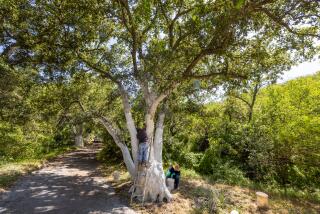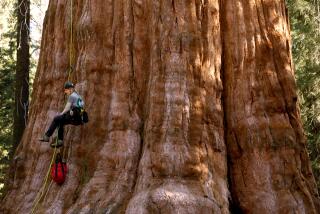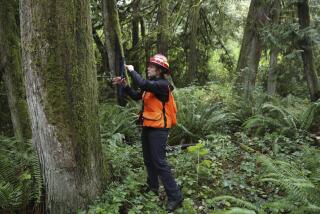Climate linked to aspen deaths
PAONIA, COLO. â From the hillsides of extinct volcanoes in Arizona to the jagged peaks of Idaho, aspen trees are falling by the tens of thousands, the latest example of how climate change is dramatically altering the American West.
Starting seven years ago, foresters noticed massive aspen die-offs caused by parasitical insects, one of them so rare it is hardly even written about in scientific literature. But with warming temperatures and the effects of a brutal drought still lingering, the parasites are flourishing at the expense of the tree, beloved for its slender branches and heart-shaped leaves that turn a brilliant yellow in autumn.
What foresters have termed Sudden Aspen Decline affects more than just aesthetics. Aspen trees provide a rich habitat for birds, elk, deer and other animals. The grasses that sprout under them -- up to 2,000 pounds per acre -- hold water that is needed by metropolitan areas. The trees do not burn easily and create natural firebreaks in forests already ravaged by the pine bark beetle -- another parasite that is thriving because of global warming.
âItâs just rolling through the forests,â Wayne Shepperd, an aspen specialist at Colorado State University, said of SAD.
Noting the number of other changes to Western vegetation due to warmer, drier temperatures, he added: âEverythingâs happening all at once. Weâre living in interesting times here.â
The decline of the tree is most visible in Colorado, which has seen nearly 500,000 acres afflicted by SAD -- nearly a fifth of its aspen groves.
Hillsides that used to draw tourists in the fall to gaze at the flickering aspen leaves are now populated only by the treesâ pale skeletons.
Remote Paonia sits in the midst of the stateâs aspen belt, with the lush, heavily forested West Elk Mountains to the east and the enormous plateau known as Grand Mesa due west.
But the flaming yellows that normally paint these landmasses have been replaced this year by the gray of bare branches.
Neal Schwieterman, Paoniaâs mayor, said people have been abuzz over conditions in Kebler Pass, home to the biggest stand of aspens in the state.
âOnly the lower levels had any aspen changing,â he said. âThere was nothing to look at high. . . . This is the least color year I can remember.â
The most vulnerable trees grow on sunny, south-facing lower elevations, where warmer temperatures wear down the treesâ resistance to pests. And though the largest number of deaths is in Colorado -- which has the most aspens -- the effect can be even more severe in places like Nevada, Arizona or California that have small bands of aspen.
Even before aspen trees began their abrupt die-off, the tree was under duress in the West.
Scientists estimate that the trees covered 10 million acres in the 19th century; now the number is 4 million.
Thatâs mainly because humans have been so successful at preventing wildfires. Regular blazes would have knocked down old aspen trunks -- freeing up new stems to emerge from the roots, where aspens regenerate. The lack of fires has also led to a sharp rise in big conifers, which crowd out aspens.
Finally, animal grazing has killed some of the younger aspens trying to survive.
Dale Bartos, a Utah-based scientist with the federal Rocky Mountain Research Station, described the one stand in Lassen National Forest in Northern California, where fencing protects nine tiny aspen bulbs from foraging animals.
âWeâre seeing these really extreme situations, where thatâs all thatâs left,â he said.
Now SAD is accelerating that loss.
The syndrome was discovered in Colorado when rangers in two national forests in the southwestern corner of the state noticed disturbing die-offs in formerly lush stands.
Researchers concluded that warmer temperatures stressed trees, especially older ones that hadnât been swept away by fire. They identified four parasites and one wasting disease that are now flourishing in the stands.
One of the parasites, the aspen bark beetle, is so rare that it had only been mentioned once before in an academic paper, scientists say.
âIf the aspen were vigorous, these things would just be taking a minor role,â said Jim Worrall, a plant pathologist for the U.S. Forest Service.
The Terror Creek drainage west of Paonia, one area where SAD was first identified, remains the focus of an intensive research project on whether the syndrome can be halted. Researchers are testing whether cutting down older aspen trees in affected areas can combat the syndrome.
The remaining, younger shoots are less susceptible to SAD.
Shepperd has worked on the project and has been discouraged by the results so far. In stands with little SAD, the cutting approach -- which he likens to amputation -- has shown some success. But the syndrome and its accompanying parasites and disease have moved so fast that stands that once had low levels of exposure are now almost entirely affected.
âWe looked at the data and said, âOh my God,â â Shepperd said.
On a recent autumn afternoon, Levi Broyles, the forest ranger who oversees the Terror Creek area, drove up a rutted dirt road through the drainage, revealing stunning views of the western slope of the Rocky Mountains.
In the foreground, however, were acres of denuded aspens. Broyles, a laconic native Westerner, gestured at the dead forest. âBecause of all the development down in the valley, this is the winter rangeâ for elk and deer, he said.
Left unsaid: The once-shady ground under the dead and dying aspen would dry out in the sun, and the vegetation that would replace the lush grasses could be inedible to some animals.
They would have to look for their sustenance elsewhere, or starve.
He stopped at one stand of trees hit moderately by SAD -- 20% to 60% of the aspens were infected.
He pointed to a saplike substance oozing from the bark of one tree, a sign of a borer eating away at it from inside.
Another treeâs bark was peeling, a sign of the disease Ceratocystis canker.
Broyles spoke matter-of-factly about the die-off but allowed that it had affected him.
âForty percent of my half-million acres is aspen habitat,â he said.
âItâs definitely near and dear to my heart.â
He drove back down to Paonia. At the Forest Service station, receptionist Anne Williams asked where he had been. When Broyles replied that heâd been up at Terror Creek, she said people had been calling asking where they could see fall color. Was there any color at Terror Creek?
âNo,â Broyles said tersely. âTerror Creek is gone.â
-
More to Read
Sign up for Essential California
The most important California stories and recommendations in your inbox every morning.
You may occasionally receive promotional content from the Los Angeles Times.










